Abstract
The objective of the study is to contribute to our understanding of the acquisition of second language intonation by comparing L2 Italian and L2 Spanish as produced by L1 Czech learners. Framed within the L2 Intonation Learning theory, the study sheds light on which tonal events tend to be successfully learnt and why. The study examines different types of non-neutral statements (narrow focus, statements of the obvious, what-exclamatives), obtained by means of a Discourse Completion Task. The findings show that the two groups diverge significantly in producing the nuclear pitch accents L+H* (L2 Spanish) and (L+)H*+L (L2 Italian), which is indicative of a target-like realization in each language. However, the learners struggle with the acquisition of the target boundary tones HL% and L!H% in L2 Spanish and prenuclear pitch accents in both Romance varieties. It is speculated that this is due not only to difficulties in acquiring semantic or systemic dimensions, but also to perceptual salience and frequency effects. In addition, the study explores individual differences and reveals no significant effects of the time spent in an L2-speaking country, the age of learning and the amount of active use of a foreign language on accuracy in L2 production.
1. Introduction
There is a certain paradox in the acquisition of intonation. On the one hand, intonation is said to be very difficult if not impossible for L2 adult speakers to acquire (Chun 1998, p. 74), and on the other, anecdotal evidence suggests that intonation is a feature of language we pick up rapidly when we learn a new language or dialect. This apparent contradiction raises the question as to which features of L2 intonation are learnt and which are not, and why this is the case.
Many language contact studies claim that intonation is very sensitive to change or convergence (e.g., Matras 2009). Changes in intonation patterns are mostly understood as products of L2 pronunciation, “imperfect” acquisition and accommodation or imitation processes. A very often cited example here is the study by Colantoni and Gurlekian (2004) of contemporary Porteño Spanish, a Buenos Aires variety, which emerged from the contact between Spanish and various Italian dialects caused by mass immigration during the 19th and early 20th centuries. Porteño shares several features with Italian, such as earlier pitch alignment in prenuclear accents, prosodic focus marking and final “long falls” in declaratives (see also Gabriel et al. 2010, 2011; Gabriel and Kireva 2014). According to Colantoni and Gurlekian, all these features can be attributed to the socio-historical context, particularly the acquisition of Spanish as a second language by immigrants. Cross-linguistic influences are also reported in many other studies, which variously show that the contact-induced forms occur in the alignment of prenuclear pitch accents (e.g., O’Rourke 2004 on Peruvian Spanish influenced by Quechua), the realization of boundary tones of questions (e.g., Romera and Elordieta 2020 on Spanish in contact with Basque) or nuclear pitch accents in different types of sentences (e.g., Sichel-Bazin et al. 2015 for the Occitan dialect spoken in Cisalpine, which is in contact with Italian).
Similarly, previous research on L2 intonation reports that L2 production shows considerable transfer from L1, as well as mixed patterns, and that learners seem to experience particular difficulties in the semantic but also the phonetic dimension (e.g., Mennen 2015; Colantoni et al. 2016; Pešková 2019; see Section 3.1 for details). Many studies provide evidence that L2 intonation is characterized by L1 features (e.g., Ueyama 1997; Gabriel and Kireva 2014; Nicora et al. 2018; Méndez Seijas 2018; Pešková 2021) and that even advanced learners can still show influences of L1 prosody in their L2 (e.g., van Maastricht et al. 2016). Yet, it is important to point out that intonation is also—at least to a certain degree—learnable (e.g., Mennen 2004; Trofimovich and Baker 2006; De Leeuw et al. 2012; Mennen et al. 2014), with learners increasingly able over time to approximate the variety to which they are exposed. The current contribution adopts an innovative approach that attempts to uncover how L1-to-L2 intonational transfer works and what role prosodic similarities and dissimilarities between languages play. It does so by comparing the intonation of two different L2s, Italian and Spanish, as produced by learners who have the same L1, Czech. After obtaining spoken data by means of a Discourse Completion Task adapted for intonation research (Prieto 2001; Prieto and Roseano 2010; Frota and Prieto 2015), intonation contours are examined within the Autosegmental Metrical (AM) model of intonational phonology (Pierrehumbert 1980).
Non-neutral statements were selected for the present study for various reasons. According to the Interface Hypothesis (Sorace 2011), adult L2 learners tend to have particular difficulty acquiring phenomena located at the external interfaces, in this case the interface of syntax with pragmatics and prosody. As we will see, the two Romance languages under study and Czech differ in the intonational realization of non-neutral statements. In narrow focus statements, for instance, Spanish focus exhibits a rising pattern, whereas Italian focus exhibits a falling or rising–falling pattern of the nuclear pitch accents. In Czech, the phonetic realization of focus is more similar to Spanish. Hence, non-neutral statements provide an interesting source to verify the L1-to-L2 transfer hypothesis and to see to what extent the Czech learners of Italian would differ from the Czech learners of Spanish. The results, discussed within Mennen’s (2015) L2 Intonation Learning theory, help us understand the degree of success with which the learners are able to approximate the target patterns and whether they struggle with patterns that are either absent in their L1 or present but used to convey a different meaning. Section 2 provides details of this cross-linguistic comparison, which we use to make several predictions about the acquisition of L2 intonation.
The “learnability” of L2 sound patterns also depends on a range of internal and external factors. Language-dependent factors such as the position of tonal events within the utterance, the type of sentence and differences or similarities between the L1 and L2 can have either a positive or a negative impact on the production of native-like intonation. Among the language-independent factors which have been claimed to affect L2 speech are the age of acquisition, the quality and quantity of input, phonological awareness, length of residence in an L2-speaking country and a range of personal factors such as proficiency level, motivation or musicality (see, e.g., Colantoni et al. 2015; Derwing and Munro 2015 for a summary of such factors and further readings). The present study looks closer at individual differences among learners, focusing in particular on the age when L2 learning was initiated, time spent in an L2-speaking country and the amount of L2 exposure per week, factors that can have an impact on L2 speech production (see, e.g., Piske et al. 2001).
The paper is structured as follows. First, the intonation of Czech, Italian and Spanish non-neutral statements is compared in Section 2. Section 3 presents Mennen’s (2015) L2 Intonation Learning theory and formulates several research questions relevant for this study. Section 4 describes the experimental design and participants in the production experiment of the study and then explains the data analysis procedure. The results are offered in Section 5 and discussed in Section 6. The contribution ends with concluding remarks in Section 7.
2. Czech, Italian and Spanish Non-Neutral Statements in Contrast
This section introduces the main suprasegmental properties of the languages under study. All three languages are regarded as intonation languages and use pitch post-lexically for grammatical and pragmatic purposes. However, in contrast to Italian and Spanish, both lexical stress languages, Czech, as a fixed-stress language with initial prominence, has been proposed to be—in Féry’s (2010) terminology—a phrase language such as, for instance, French (Pešková 2017, forthcoming). According to Jun’s (2005, 2014) model of prosodic typology, Italian and Spanish are head-prominence languages, assigning phrase-level prominence by the phrase head, which is determined by a metrically strong syllable, whereas Czech is a head/edge-prominence language, since it marks phrase-level prominence by both the phrase head (stressed syllable, T*) and the edge at the phrase level (Ta), corresponding to Accentual Phrases (APs) (examples illustrating this feature are given in Section 2.1).
With regard to intonational properties, Italian and Spanish can be described as intonationally “richer” in comparison to Czech, in that they have a greater number of different pitch accents and boundary tones, which can be combined in different numbers of nuclear configurations (see Pešková 2017 for Czech; Gili Fivela et al. 2015 for Italian; Prieto and Roseano 2010 for Spanish). One nuclear configuration can convey one or more meanings in every language, but languages may differ substantially in this respect. For example, the L*+H pitch accent, which is phonetically realized as a F0 valley on the accented syllable with a subsequent rise on the postaccentual syllable, is a typical prenuclear pitch accent of information-seeking yes–no questions in (Peninsular) Spanish (Estebas-Vilaplana and Prieto 2010). The same tone represents a focus nuclear accent in Czech non-neutral statements or yes–no questions (Pešková 2017), whereas in various Italian regional varieties, it occurs in the nuclear position of different types of sentences, including yes–no questions, wh–questions and exclamatives (Gili Fivela et al. 2015).
It must be added that there is considerable variation in terms of intonation among the various regional varieties. It should therefore be clarified that the Spanish variety I refer to is that spoken on the Iberian Peninsula, known as Peninsular Spanish, because that is the variety to which most of the Spanish-learning participants in this study were exposed. As for Italian, most of the Italian-learning participants were exposed to various northern varieties of Italian (see Section 4.2 for details).
Since the comparison of intonation patterns serves as a point of departure for the examination of L2 pitch contours, the following subsections present the intonational contours of non-neutral statements in L1 Czech (Section 2.1), L1 Italian (Section 2.2) and L1 Spanish (Section 2.3).
2.1. Non-Neutral Statements in Czech
The realization of the nuclear configuration in non-neutral statements with contrastive focus typically consists of a low tone on the stressed syllable with a rise on the posttonic syllable (L*+H), followed by a low boundary tone (L%) (Figure 1). An alternative variant of this pattern is a rising tone on the accented syllable (labelled as L+H*), when the word is disyllabic (Pešková forthcoming). All items, contexts and examples are taken from the corpus of the present study, which is presented in Section 4.
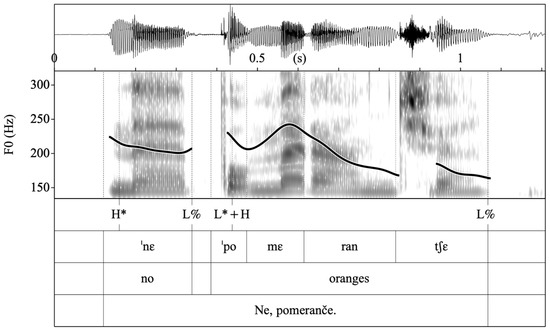
Figure 1.
Waveform, spectrogram and F0 trace of the contrastive focus statement No, oranges! in L1 Czech produced with L*+H L%.
Whereas we find the same nuclear configuration, L*+H L%, in statements of the obvious (Figure 2), the tonal structure of what-exclamative statements resembles that of wh-questions in Czech, in which the contour starts mostly with a high or rising tone at the very beginning of the utterance and ends with a fall (Figure 3).
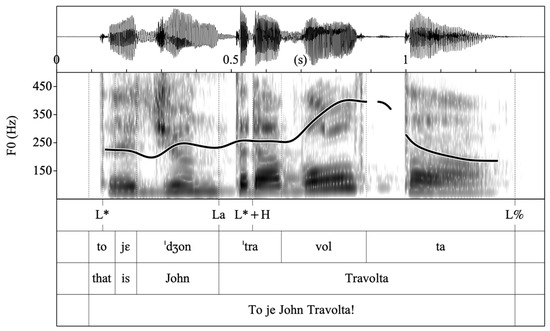
Figure 2.
Waveform, spectrogram and F0 trace of the non-neutral statement of the obvious It is John Travolta! in L1 Czech produced with L*+H L%.
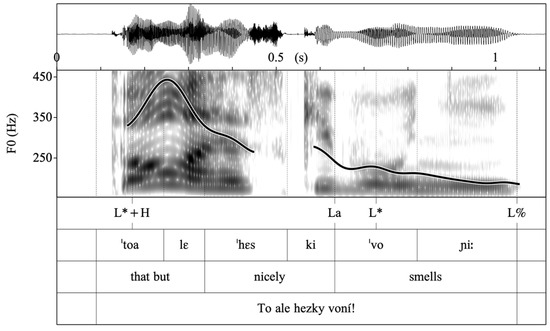
Figure 3.
Waveform, spectrogram and F0 trace of the what-exclamative statement What a lovely smell! in L1 Czech produced with L* L%.
2.2. Non-Neutral Statements in Italian
In most Italian varieties, non-neutral statements of contrastive focus and statements of the obvious are characterized by a nuclear pitch accent that is phonetically realized as a rise and a fall located within the stressed syllable (Figure 4). I use a tritonal phonetics-based label for this pattern, L+H*+L, in order to capture the exact movement of the pitch track within the stressed syllable. In Gili Fivela et al. (2015), different phonology-based labels, such as H*+L, L+H* or L*+>H, are proposed for this pattern, depending on the regional variety. In my analysis, the H*+L pitch accent is treated as another variant of L+H*+L, in which the high peak is aligned with the left edge of the stressed syllable (Figure 5). The phonetics-based labels applied in this study are presented in Section 4.
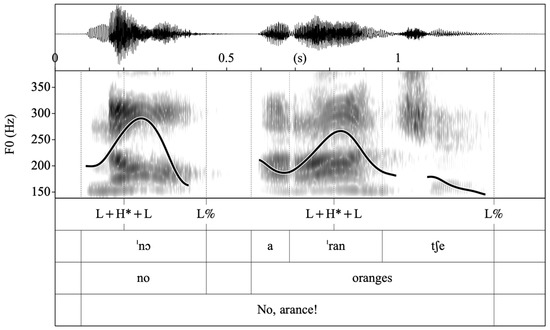
Figure 4.
Waveform, spectrogram and F0 trace of the contrastive focus statement No, oranges! in L1 Italian produced with L+H*+L L%.
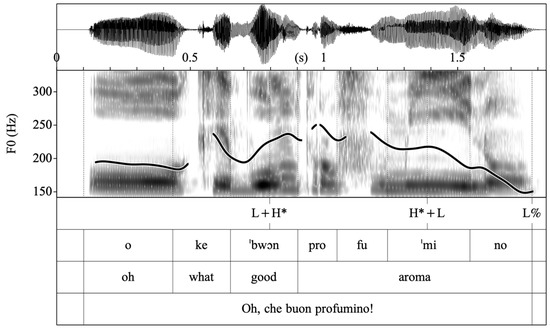
Figure 5.
Waveform, spectrogram and F0 trace of the what-exclamative statement What a lovely smell! in L1 Italian produced with H*+L L%.
As for what-exclamative sentences, they show more variation in the nuclear configuration pattern; however, here again the most general pattern is what I label L+H*+L L% (for further details see Gili Fivela et al. 2015). The L*+>H pitch accent has been reported for various northern varieties in Gili Fivela et al. (2015) and was detected in the present L1 data too (Figure 6). This pitch accent is phonetically realized as a “F0 fall to the [tone bearing unit] followed by the rise to an early peak in the tonic syllable” (Gili Fivela et al. 2015, pp. 164–65).
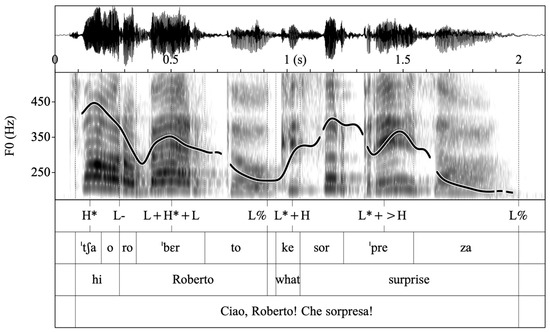
Figure 6.
Waveform, spectrogram and F0 trace of the what-exclamative statement Hi, Roberto! What a surprise! in L1 Italian produced with L*+>H L%.
2.3. Non-Neutral Statements in Spanish
According to previous research (see Prieto and Roseano 2010), (Peninsular) Spanish non-neutral statements with a contrastive focus and exclamative statements are realized with the nuclear rising L+H* pitch accent and a low boundary tone L% (Figure 7). The L+H* focus accent has been observed in many Spanish varieties.
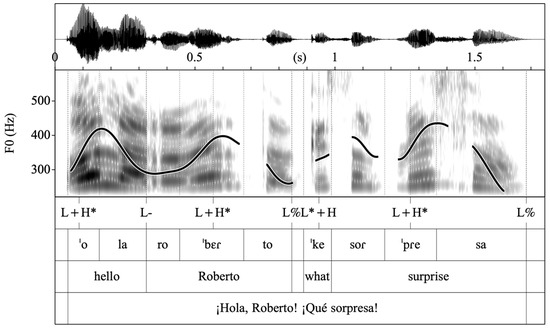
Figure 7.
Waveform, spectrogram and F0 trace of the what-exclamative statement Hi, Roberto! What a surprise! in L1 Spanish produced with L+H* L%.
In contrast to Czech and Italian, statements of the obvious in Spanish show two different patterns: L+H* L!H% (Figure 8) and L+H* HL% (Figure 9). Though the latter contour is not attested in non-neutral statements in Prieto and Roseano (2010), it was produced systematically by the control participants in the present study in the context presented in Figure 9 (see Section 4.1 for details).
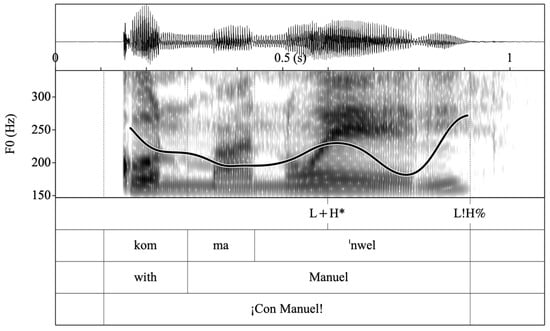
Figure 8.
Waveform, spectrogram and F0 trace of the statement of the obvious To Manuel! in L1 Spanish produced with L+H* L!H%.
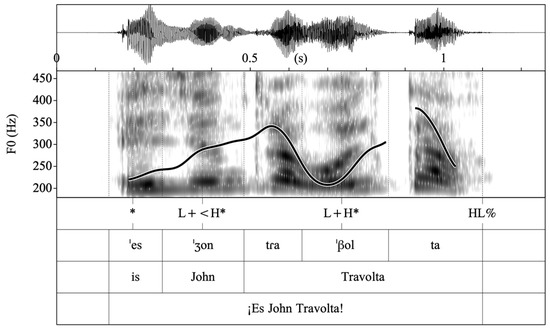
Figure 9.
Waveform, spectrogram and F0 trace of the statement of the obvious It is John Travolta! in L1 Spanish produced with L+H* HL%.
It should be noted that languages can be phonetically similar but phonologically different. An example is given with the trisyllabic name Travolta. In Czech, the accent is on the first syllable tra (Figure 2), but the rise coincides with the position of the stress in Romance languages, which is on the second syllable vol (see Spanish example in Figure 9). Furthermore, the languages differ in the realization of the prenuclear position, here attested in the Travolta sentence. Czech shows a tendency towards a pre-focal tonal compression (Figure 2) or it realizes an L*+H pitch accent in the very initial position, whereas Spanish typically uses a prenuclear pitch accent realization, with a rising tone with the peak on the postaccentual syllable (L+<H*) of the name John. The Italian counterpart is very similar to Spanish, consisting of a rising–falling–rising–falling pitch track over the whole utterance. However, the tune–text association is different. In the prenuclear position, Italian uses an L+H* pitch accent and the nuclear configuration is L+H*+L L% (Figure 10). The copular verb is deaccented in both Italian and Spanish (marked with *).
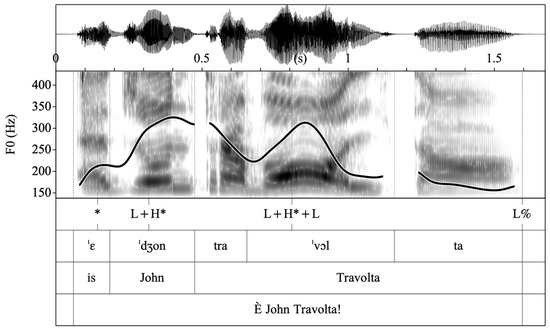
Figure 10.
Waveform, spectrogram and F0 trace of the statement of the obvious It is John Travolta! in L1 Italian produced with L+H*+L L%.
2.4. Brief Summary
The most important characteristics of non-neutral statements in the three languages can be summarized as follows (see Table 1): Czech displays two main patterns, L*+H L% and L* L%, Italian varieties exhibit mostly a (L+)H*+L L% nuclear configuration and, finally, Spanish presents a nuclear pitch accent L+H* with three different boundary tones, L%, L!H% and HL%.

Table 1.
Summary of the main tonal patterns of non-neutral statements in Czech, Italian and Spanish.
Based on these tonal differences, Czech learners of Italian have to learn a new pattern, (L+)H*+L, which does not exist in Czech. Boundary tones of non-neutral statements in Italian should not present any difficulty for learners, since they end with a low pattern (L%) in both languages. In contrast, Czech learners of Spanish might have more difficulties with the acquisition of the boundary tones given that HL% does not exist in Czech and L!H% (or its variant LH%) is used in different types of yes–no questions. As for the Spanish nuclear pitch accent, it can be expected that Czech learners of Spanish are able to approximate the target pattern quite well, since the L+H* tone exists as a phonetic variant of L*+H in Czech.
Before presenting the research questions that arise from this cross-linguistic comparison in Section 3.2, the L2 Intonation Learning theory (Mennen 2015) is presented in Section 3.1.
3. Acquisition of L2 Intonation
3.1. L2 Intonation Learning Theory
This section provides an overview of the main ideas and postulations of Mennen’s (2015) L2 Intonation Learning theory (LILt), the theoretical framework for the present study. Cross-linguistic comparison is an essential point of departure for this model. This is because, in order to understand the acquisition of L2 intonation and predict potential difficulties, it is necessary to know how the L1 and L2 differ from each other. As already noted in Section 2, Czech has fewer patterns than Italian or Spanish, and Czech learners may thus be assumed to face difficulties in acquiring some of the intonation patterns of these two languages. Adapted from Ladd (1996, 2008), LILt assumes that languages differ across four dimensions: (1) systemic, (2) phonetic, (3) semantic and (4) frequency. These dimensions can help to understand where L2 deviations from the target L1 norm are likely to occur.
The systemic dimension refers to the inventory of categorical phonological elements. Here, the question is whether the L2 learners can produce those tonal events that do not form part of their L1 tonal inventory. For example, in Mennen et al. (2010), Italian and Punjabi learners of London English do not use the target complex pitch accents H*LH and L*HL, which are present in the variety of English they were learning but not in their respective L1s.
The phonetic dimension is about how tonal tunes are implemented phonetically. Previous research has shown that learners have particular problems with the realization of target-like tonal alignment, tonal scale and tonal slope. For example, pitch accents in the initial position of yes–no questions in L1 (Peninsular) Spanish exhibit a wider pitch range when compared with L2 Spanish produced by Czech learners, reflecting transfer from their L1 (Pešková 2020). As another example, Mennen (2004) found that Dutch learners of Greek tended to align the prenuclear peaks in declarative sentences much earlier than L1 Greek speakers, in spite of very long exposure to the L2. Nevertheless, learners can also overshoot the L1 norms, as Santiago and Delais-Roussarie (2015) showed for L1 German and L1 Spanish learners of French, who tended to exaggerate the rises at the right edge of non-final clauses in French.
The semantic dimension refers to the functionality or distribution of the tones. The same tone can be used in different contexts and radically change the meaning. An example is the high-rising terminal in English statements (uptalk), which should be avoided in any L2 where statements require a falling pattern (see, e.g., Méndez Seijas 2018 for L2 Spanish). There is also evidence for differences across regional varieties of a single language (of course, this holds for other dimensions too). For instance, in most Spanish varieties, yes–no questions are signaled by rising pitch, whereas Caribbean varieties use falling patterns (Hualde and Prieto 2015). Many studies report difficulties in this dimension and reveal patterns transferred from learners’ L1s. For example, Nicora et al. (2018) identify the difficulties that Irish English-speaking learners of Italian have with yes–no questions, in that they tend to apply L1-based H+H* H% and H+H* L% patterns instead of the target contours, H*+L LH% and L*+H L%. The study attributes this to a low phonological/semantic awareness on the part of the learners; however, the same study demonstrates that explicit intonation training can help to improve L2 productions.
Finally, the frequency dimension concerns how frequently certain intonation patterns occur. Languages differ substantially in this regard. For instance, German learners of L2 Spanish have been found to use rising boundary tones more often in neutral wh-questions in L2 Spanish than do Czech learners of Spanish, who realize more falls (Pešková 2021). This result is clearly due to influences from the respective L1s. The falling pattern in Czech is also common in vocatives (initial calls), another feature that is easily transferred to L2 Italian and L2 Spanish (Pešková 2019).
Apart from a characterization of cross-language differences along four dimensions of intonation, LILt makes five theoretical generalizations and predictions that seek to explain why difficulties in learning foreign intonation acquisition arise and which principles “govern the acquisition process of intonation” (Mennen 2015, p. 178). I summarize the five predictions very briefly below.
- The first assumption is that many difficulties are connected with perceptual difficulties, much as Flege’s (1995) Speech Learning Model and Best and Tyler’s (2007) Perceptual Assimilation Model of L2 speech learning assume for L2 segments. In addition, Mennen offers further clarification for individual learner difficulties in L2 intonation acquisition, suggesting that they may be due to factors such as an inability to articulate certain aspects of the L2 and store them in acoustic memory (p. 179).
- LILt postulates that the position and context in which intonation contrasts between L1 and L2 occur are important and need to be controlled for (p. 179). Pešková (2020) shows that L1 Czech learners of L2 Spanish or L2 Italian have more difficulty acquiring the initial and medial prenuclear positions when compared with nuclear positions in neutral statements. Possible explanations might be transfer from the L1, but also include the fact that the positions are less perceptually salient and that nuclear configurations are more important bearers of meaning.
- The model predicts fewer intonation deviations when exposure to the L2 starts at an earlier age (pp. 180–81). The age of learning (AOL) has been shown to have an important impact on the degree of foreign accent and L2 production in general.
- The fourth assumption is connected to developmental sequences and the prediction that, in the course of time, learners learn to approximate the targets more closely. For instance, Mennen et al. (2010), so far one of very few longitudinal studies on intonation development, observed an improvement after 30 months in the ability of Punjabi and Italian learners of English to approximate intonational targets.
- The last assumption of LILt is that L1 and L2 categories exist in a common phonological space and that linguistic influence is bi-directional (p. 184). Interaction between the L1 and L2 in the form of assimilation or mixed patterns has been observed, especially in individuals who have been living in an L2-speaking country for a long period (e.g., Flege 1987 for segments; De Leeuw et al. 2012 for intonation).
3.2. Research Questions
First of all, the present study aims to test in what way the two groups of learners differ from each other and how they are able to approximate the target patterns. As such, we seek to answer whether all tonal events are acquired equally or whether certain tonal events present specific difficulties for learners. The study tests the position (prenuclear, nuclear, boundary) in which intonation contrasts appear and examines whether the intonation dimensions constitute disparate degrees of difficulty, as LILt suggests (Mennen 2015, p. 183). Taking into consideration the cross-language comparison presented in Section 2 and focusing on systemic and semantic dimensions, we can predict that Czech learners will have problems with (1) the acquisition of Spanish HL% and Italian (L+)H*+L, tones absent in their L1 inventory (systemic dimension), and (2) the appropriate use of L!H% in L2 Spanish non-neutral statements, since this tone exists in Czech yes–no questions (semantic dimension).
Secondly, given the large amount of variability in the data, we examine whether the age of learning (AOL), the length of residence (LOR) and the amount of active use of L2 (AUL) can explain L2 deviations across speakers. As mentioned above, LILt predicts a better performance when language exposure starts earlier. By the same token, having spent time in an L2-speaking country is reported in many previous studies to have enhancing effects on L2 speech (e.g., Flege et al. 1997; Henriksen 2012), although there is no consensus on exactly how long the period should be. Some studies on L2 phonology even report a weak impact or no impact at all (e.g., Oyama 1976; see Piske et al. 2001 for an overview of research on this variable). The present study discusses whether the general assumption “the younger, the better” is justified and whether learners with a longer LOR perform more accurately in terms of intonation than those learners with less or no experience abroad. And, finally, it is tested whether the amount of input, here the active use of L2, correlates with intonational accuracy (meaning that the learner can appropriately produce a tonal pattern pertaining to the target language, regardless of whether it is present in their L1 or not).
Summarizing the above, the following questions are addressed:
- Q1: In what way do L2 Italian learners differ from L2 Spanish learners?
- Q2: In what way do the two L2 groups differ from L1 Spanish and Italian controls?
- Q3: Is it more difficult for L2 learners to acquire new patterns (systemic dimension) or put known patterns to new uses (semantic dimension)?
- Q4: Which individual factors (AOL, LOR, AUL) explain accuracy in L2 patterns?
4. The Production Experiment on the Intonation of L2 Italian and L2 Spanish
4.1. Experimental Design
The data were collected within the scope of a larger study on L2 Italian and L2 Spanish phonology, which comprised a combination of five different tasks (see Pešková 2020, following Pustka et al. 2018). For the purposes of the present study, only data from the Discourse Completion Tasks (DCTs) were selected and analyzed. DCTs are a data-gathering method that was originally developed for the study of pragmatics (Blum-Kulka et al. 1989) and later became popular in L1 intonation research (see, e.g., Frota and Prieto 2015 for Romance languages). In the task, participants are presented with a set of daily situations and asked to react accordingly (e.g., “Imagine that you see Natalia, a friend of yours, on the other side of the street. Call her”). The selection of items for the present study was based on the Spanish version of the DCT employed in Prieto and Roseano (2010), but it was adapted for L2 research and performed in two steps. In the first step, the participant reacted to the situations presented spontaneously (as expected in the original DCT procedure). In the second step, the participant was given a prepared answer embedded in the context and was asked to say it aloud as naturally as possible. Only the answers from the second step were included in the subsequent analysis, since they showed more fluency and sounded more natural in comparison to the spontaneous reactions produced in the first step. The advantage of this process was also that the utterances were identical across all participants tested, allowing a greater degree of control over factors other than intonation, and thus ideal for comparison purposes.
The full set of DCTs used in Pešková’s (2020) prompt scenarios included 25 situations (in Spanish or Italian) intended to elicit a variety of different sentence types, such as statements, vocatives, exclamatives, imperatives, yes–no questions and wh-questions, with either neutral or biased meanings (e.g., counter-expectational echo questions, confirmatory questions, statements of the obvious or command imperatives). The five following scenarios leading to the production of non-neutral statements represent the focus of the present study.1
- 6.
- Contrastive focus on the object
- 7.
- Situation (S04): “You enter a store where the shop attendant is a little hard of hearing. You tell her that you would like a kilo of oranges, but she doesn’t hear you well and asks you if you want lemons. Tell her that you want oranges.”
- 8.
- Answer:
- 9.
- It. No, arance.
- 10.
- Sp. No, naranjas.
- 11.
- ‘No, oranges.’
- 12.
- Statement of the obvious (surprise nuance)
- 13.
- Situation (S05): “You are with a friend and you tell him/her that Mary, a mutual friend of yours, is getting married. Your friend asks you who she is marrying. You’re surprised that s/he doesn’t know, because everyone knows that Mary is planning to marry her long-time boyfriend, Manuel. Tell him/her that she’s getting married to Manuel.”
- 14.
- Answer:
- 15.
- It. Con Manuele!
- 16.
- Sp. ¡Con Manuel!
- 17.
- ‘To Manuel!’
- 18.
- Statement of the obvious (exclamative nuance)
- 19.
- Situation (S15): “You show a picture of a very famous actor to your friend. S/he asks you who it is. This astonishes you, because everybody knows who the actor is. How do you react?”
- 20.
- Answer:
- 21.
- It. (Ma come!) È John Travolta!
- 22.
- Sp. ¡Es John Travolta!
- 23.
- ‘It’s John Travolta!’
- 24.
- What-exclamative sentence (positive evaluation)
- 25.
- Situation (S16): “You are invited for dinner at your friend’s place and when you arrive you smell a delicious aroma. What do you say to your friend?”
- 26.
- Answer:
- 27.
- It. Che buon profumino!
- 28.
- Sp. ¡Qué rico olor!
- 29.
- ‘What a lovely aroma!’
- 30.
- What-exclamative sentence (positive surprise)
- 31.
- Situation (S18): “Somebody knocks on the door. You open it and there is your friend Robert. You have not seen him for years. How do you react?”
- 32.
- Answer:
- 33.
- It. Ciao, Roberto! Che sorpresa!
- 34.
- Sp. ¡Hola, Roberto! ¡Qué sorpresa!
- 35.
- ‘Hi, Roberto! What a surprise!’
Before the experiment, all learners gave written consent to be recorded and filled out a questionnaire to provide information about their language background such as the age they had started learning the L2 in question, how much of the L2 they used per week, how long they had lived in a country where that L2 was spoken and their knowledge of other foreign languages.
After they had carried out the DCT experiment in the L2, the learners were recorded performing the DCT again, this time in their L1, Czech.
4.2. Participants
The study included 52 participants: 20 Czech learners of Italian, 20 Czech learners of Spanish and 12 controls (six L1 Italian speakers, six L1 Spanish speakers). All learners had grown up with Czech as their only L1 and had started to learn Italian or Spanish in a formal setting—mostly in secondary school or university—in the Czech Republic. None of the learners had received any pronunciation training and were not aware of the aims of the production experiment in which they participated for this study.
The learners were selected according to their L2 proficiency levels, as indicated by the level of the courses they were attending at the time of the experiment; their proficiency ranged from B1 to C2 according to the Common European Framework of Reference for Languages (CEFR 2018). I use data from a previous study (Pešková 2020) that aimed to measure differences in intonation acquisition across different proficiency levels which might suggest improvement over time. Basic-level learners (A1–A2) were not included in the study because their spoken output is mostly limited to very simple structures and is more strongly characterized by transferred phenomena. It should be added that Pešková (2020) reports that proficiency level shows only a slight correlation with L2 intonation acquisition. The present study also reveals a non-significant effect between B and C levels (χ²:(13) = 13.57, p = 0.406) and speculates that this may be due to the fact that the B2 and C1 levels of the participants were not in reality very far apart and the assignation of learners to a particular proficiency level is generally based upon grammatical and lexical skills, rather than phonological competencies. Another possible explanation is that intonation becomes fossilized at the B2 level or even earlier. For this reason, the students’ purported language proficiency level is not taken into account in the present paper.
Let us now turn our attention to inter-participant variability. As we will see, L2 classes, especially in the learners’ home country, are characterized by great irregularities (see Table A1 in Appendix A for details). Starting with the variety of Italian or Spanish to which learners had been exposed, they reported having non-native, as well as native, instructors. Spanish-speaking instructors mostly came from mainland Spain (mostly Madrid), though a few came from the Canary Islands or various Latin American countries (Mexico, Chile, Peru). As for Italian-speaking instructors, the majority came from the northern dialect areas of Italy (Turin, Verona, Milan). For this reason, the two groups of control speakers consisted of six L1 speakers of mainland Iberian Spanish (4F, 2M) (Madrid, Ciudad Real) and six L1 speakers from the north of Italy, mostly Turin (4F, 2M). It should be mentioned that it was very difficult to find learners who had been exposed to a single dialect. Although the majority of participants had had more contact with Peninsular Spanish, or northern Italian varieties, they also reported having native-speaking contacts (mostly friends) from other dialect areas. With regard to the learners’ L1, the participants spoke Standard Czech and came from two main dialectal areas (Bohemian and Moravian). According to the available descriptions (see, e.g., Palková 1994) and our L1 control data of the present study, there are no substantial differences between the two varieties in terms of intonation that are relevant for the present study.
Regarding the age of learning (AOL), the participants began to learn the L2 at or after puberty. The average AOL was 17 for L2 Spanish learners and 19 for L2 Italian learners, respectively. The lowest AOL was 10 (in the case of three learners) and the highest AOL was 33 and 35 (in the case of another three learners). Other factors that were difficult to control for were the sex of participants (female participants predominated), their knowledge of other foreign languages (mostly, but not exclusively, English)2 and the degree of active exposure to or use of Italian/Spanish per week. About half of them used Italian/Spanish less than three hours a week, whereas the other half used it more than ten hours weekly. The amount of time spent in an L2-speaking country also differed considerably from one participant to another. Some of them had spent only a short period of time abroad (e.g., holidays), whereas others had lived abroad for a full year or more. Few of the learners had no experience at all in an L2-speaking country.
All these factors can shape the features of an individual’s pronunciation (see Piske et al. 2001 for an overview and discussion). As already mentioned in Section 3.2, we next have a look at the role of individual differences and discuss three external factors that might have underlain L2 intonation deviations from target patterns.
4.3. Tonal Analysis
The data were transcribed first orthographically and then phonetically. The acoustic analysis was carried out with Praat software, version 6.1.48, (Boersma and Weenink 1992–2022) and the tonal annotation was done manually by the author, applying AM-based labels phonetically.3 This phonetic approach to labeling, which was oriented to the IPrA approach (Hualde and Prieto 2016), proved to be well suited for the analysis of L2 data. The broad tonal transcription (Elvira-García et al. 2016), in which the F0 course is described, was provided merely for practical purposes, that is, to help systematize and compare the patterns found in the L2 data. In the full corpus of recorded material, two monotonal pitch accents (H* and L*), five bitonal pitch accents (L*+H, L+H*, L+<H*, H+L*, H*+L) and two tritonal pitch accents (L+H*+L and H+L*+H)4 were identified (Figure 11). As for boundary tones, three monotonal boundary tones (H%, L%, !H%), three bitonal boundary tones (HL%, L!H%, LH%) and one tritonal boundary tone (LHL%) were identified in the data (Figure 12).

Figure 11.
Schematic representation of pitch accents found in the data (Pešková 2020).

Figure 12.
Schematic representation of boundary tones found in the data (the dotted line indicates alternative pitch tracks) (Pešková 2020).
The corpus for the present analysis consisted of 260 target non-neutral statements and 1040 tonal events, comprising prenuclear and nuclear pitch accents and boundary tones at the intonational phrase (IP) or intermediate phrase (ip) within the Prosodic Hierarchy (see, e.g., Selkirk 1984). The number also included the greeting (S18; ‘Hi, Roberto!’) and the negative particle no (S04; ‘No, oranges’), since they revealed some interesting tendencies in the two L2 varieties.
5. Results
5.1. Intonational Patterns
In the dataset, several substantial differences between the two L2 varieties were found. Given that we are interested in frequency distributions across groups and we are dealing with categorical data, differences are assessed using either chi-square or Fisher’s exact tests.
First of all, the frequency of use of particular pitch accents was calculated and showed different tendencies: while L+H* (a rising tone on the stressed syllable) predominated in both L1 and L2 Spanish (75% and 46%, respectively), more mixed patterns were produced in the two sets of Italian data. In L1 Italian data, 49% of all pitch accents were realized as either H*+L or its variant L+H*+L, followed by L+H* (24%). In the L2 Italian data, the various patterns were more evenly distributed (Figure 13). It should be added that two cases of tritonal pitch accent H+L*+H were detected in the Italian data too, but they were clustered here into the L*+H group to keep the overall picture simple. The results revealed statistically significant differences between the two groups of learners (χ²:(6) = 122,932; p < 0.001), as well as between the L1 and L2 varieties (for Italian, χ²:(5) = 16,287; p = 0.006; for Spanish, χ²:(6) = 14.87, p = 0.021).
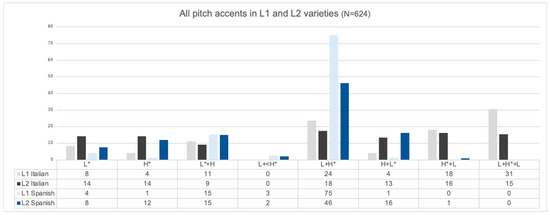
Figure 13.
Tonal patterns of all pitch accents found in all L1 and L2 data (in %).
Now we take a closer look at the realization of pitch accents, grouping them according to whether they were located in prenuclear or nuclear position. Starting with the nuclear position, a crucial difference between Italian and Spanish varieties can be observed (Figure 14). Setting aside L*, H*, L*+H and L+<H*, which appeared with a very low frequency in the data or were completely absent, we can summarize the findings as follows: both Spanish groups showed a clear preference for a rising L+H* nuclear pitch accent (L1 Spanish: 100%; L2 Spanish: 62%). In the two Italian varieties, on the other hand, high–falling (H*+L) and rising–falling (L+H*+L) patterns predominated (L1 Italian: 73%; L2 Italian: 44%). This position also shows significant differences between L2 Spanish and L2 Italian (χ²:(5) = 119,540; p < 0.001), between L2 and L1 Italian (χ²:(5) = 15,475; p = 0.009) and between L1 and L2 Spanish (Fisher’s exact test; p < 0.001).5
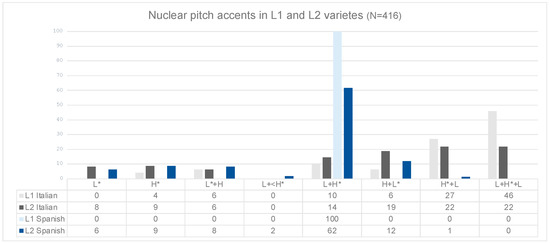
Figure 14.
Tonal patterns of nuclear pitch accents found in all L1 and L2 data (in %).
There were also differences across groups in the production of prenuclear pitch accents, which displayed a great deal of variation (Figure 15). It should first be noted that the sample of prenuclear pitch accents in the data was very small, hence a certain degree of caution is required here. Prenuclear accents only occurred in the sentence It is John Travolta and in the very initial position of what-exclamative sentences. Nonetheless, some interesting tendencies can be reported. First, L1 Italian controls produced at a high frequency two bitonal pitch accents, L+H* (50%) and L*+H (21%), and a monotonal L* pitch accent (25%). The latter was used in the sentence È John Travolta and indicates a deaccenting of the verb. L1 Spanish controls produced L*+H (46%) and L+H* (25%) with the highest frequency. In both control groups, L*+H was labeled at the beginning of the what-exclamative What a surprise! (S18). Considerable variation occurs in the L2 varieties too: L2 Spanish exhibited H+L* (25%), L*+H (23%) and L+H* (21%) with the highest frequency; L2 Italian learners produced L* (26%) with the highest frequency, closely followed in terms of frequency by the two monotonal patterns H* (25%) and L+H* (24%) (χ²:(6) = 29,012; p < 0.001; for all tonal realizations in the prenuclear position). With a few exceptions, the learners diverged from the target languages in this position; the difference was significant between the L1 and L2 Italian varieties (Fisher’s exact test; p = 0.019), as well as between the two Spanish groups (Fisher’s exact test; p = 0.025).6
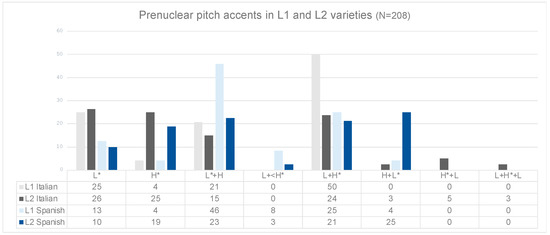
Figure 15.
Tonal patterns of prenuclear pitch accents found in all L1 and L2 data (in %).
The results for boundary tones (IP) show much less variation. 97% of all non-neutral sentences were produced with an L% boundary tone in L1 Italian, followed by L2 Italian (94%) and L2 Spanish (86%). As expected, the non-neutral statements in L1 Spanish show a different pattern here (Section 2.3): 64% of the statements were produced with L% boundary tones, 19% with HL% and 14% with L!H% (Figure 16). No significant differences were obtained for L1 and L2 Italian varieties (Fisher’s exact test; p = 0.064) and between L2 Italian and L2 Spanish (Fisher’s exact test; p = 0.884). The only significant difference was found between L2 Spanish learners and L1 Spanish controls (Fisher’s exact test; p < 0.001).

Figure 16.
Tonal patterns of all boundary tones at the intonational phrase found in all L1 and L2 data (in %).
With regard to the L1 Spanish data, it should be recalled that the bitonal L!H% pitch accent is a contour typical of statements of the obvious. The control participants also predominantly produced HL% in the sentences with nuances of surprise (Es John Travolta and Qué sorpresa). One statement, the greeting, was produced with LHL% at the end of the vocative (Hola, RobertoLHL%) by one L1 Spanish participant. Interestingly, this tone is described as characteristically used for exhortative requests in the Spanish_ToBI (see Aguilar et al. 2009). L2 Spanish learners also produced slightly more different patterns than L2 Italian learners, but these patterns did not resemble those produced by the controls. For instance, the L!H% was produced once in the statement of contrastive focus (No, naranjasL!H%) and only once in the expected statement of the obvious (Con ManuelL!H%). The HL% boundary tone appeared seven times in the data with exclamative sentences or statements of the obvious. Recall that L!H% expresses different types of (mostly yes–no) questions in Czech, while HL% seems to be absent in Czech according to the L1 controls and previous empirical studies (see, e.g., Duběda 2014; Pešková forthcoming).
As for the boundary tones at the intermediate phrase, appearing only at the end of the greeting ciao/hola and after the negative particle no in our case, L1 Italian controls produced a low boundary tone (L-) in 100% of cases and L1 Spanish controls did so in 92% of cases. Both groups of Czech learners produced here an H- boundary tone in 20% and a L-boundary tone in 80% of cases, respectively. Interestingly, all boundary tones were combined with L+H* in L1 Spanish, whereas we find either L+H* or (L+)H*+L in L1 Italian. L2 Italian learners showed a mixed picture, using predominantly a falling pattern H+L* and, in three cases, a focus pattern H*+L after the particle no and the greeting ciao, whereas L2 Spanish learners produced a rising L+H* pattern in about half of cases and, in the other half, a falling H+L* pattern, aside from a few isolated cases of L* or H*.
I conclude this section by presenting some specific examples from the data (for further examples of narrow focus statements and statements of the obvious see Pešková 2020). The following four figures illustrate the main differences observed in the two L2 varieties. The first pair exemplifies non-neutral statements (exclamatives) in L2 Italian, in which the L+H*+L pitch accent was produced. Notice that we find the pattern in the prenuclear position of buon (Figure 17) and on the vocative Roberto too (Figure 18).
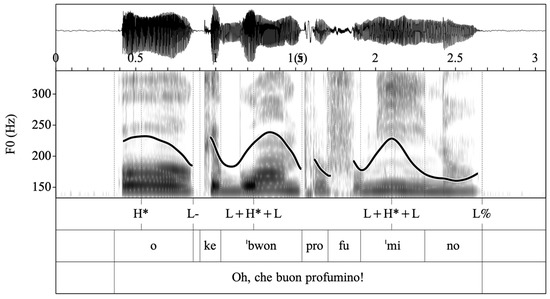
Figure 17.
Waveform, spectrogram and F0 trace of the what-exclamative Che buon profumino! in L2 Italian (F32, level B1) produced with the target-like L+H*+L L% pattern.
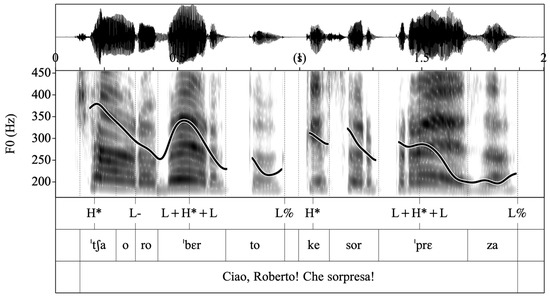
Figure 18.
Waveform, spectrogram and F0 trace of the what-exclamative Ciao, Roberto! Che sorpresa! in L2 Italian (F34, level B2) produced with the target-like L+H*+L L% pattern.
The second pair offers the same sentences in L2 Spanish, realized with L+H* in the nuclear position in both cases; the latter one was produced with an upstep (¡) (Figure 19 and Figure 20).
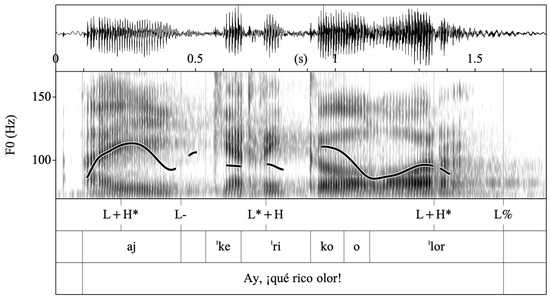
Figure 19.
Waveform, spectrogram and F0 trace of the what-exclamative ¡Qué rico olor! in L2 Spanish (M17, level C1) produced with the target-like L+H* L% pattern.
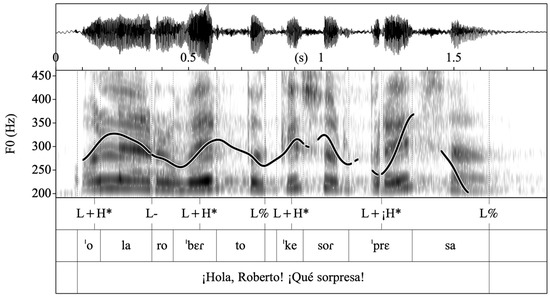
Figure 20.
Waveform, spectrogram and F0 trace of the what-exclamative ¡Hola, Roberto! ¡Qué sorpresa! in L2 Spanish (F16, level C2) produced with the target-like L+¡H* L% pattern.
Not all sentences showed a target-like form. The L2 data yielded several patterns that were completely absent from the Italian or Spanish control data. The following two pairs of non-neutral statements represent what I would call a typical Czech intonation pattern. The exclamative statement in the first two examples begins with a high monotonal plateau on the wh-word what (It. che / Sp. qué), extended to the adjective, from which the pitch track simply falls (Figure 21 and Figure 22).
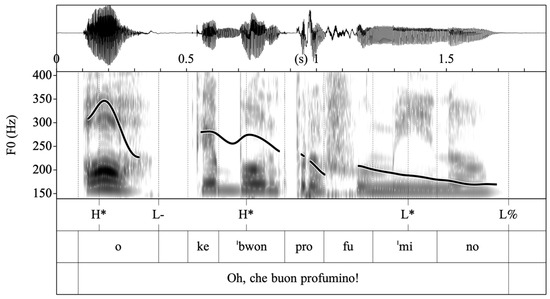
Figure 21.
Waveform, spectrogram and F0 trace of the what-exclamative Che buon profumino! in L2 Italian (F38, level C2) produced with L* L%.
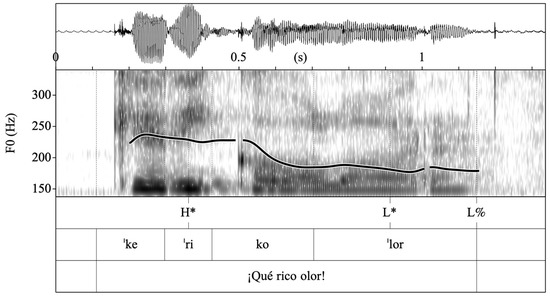
Figure 22.
Waveform, spectrogram and F0 trace of the what-exclamative ¡Qué rico olor! in L2 Spanish (F20, level B1) produced with L* L%.
We find a very similar intonation pattern (H* L* L%) in another L2 Italian example (Figure 23). Additionally, the vocative Roberto is realized here with a very low plateau that resembles the Czech pattern in such a position.

Figure 23.
Waveform, spectrogram and F0 trace of the what-exclamative Ciao, Roberto! Che sorpresa! in L2 Italian (F35, level C1) produced with L* L%.
In the L2 Spanish counterpart (Figure 24), we find a contour that is almost identical to the greeting seen in the Italian example. As for the nuclear configuration, it was realized with a Czech focal pattern L*+H; as we can see, the speaker produced the word sorpresa (‘surprise’) with the accent placed on the first syllable instead of on the second syllable.
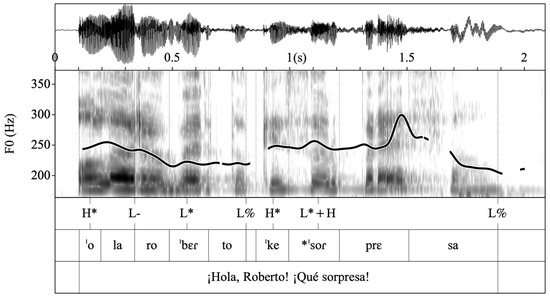
Figure 24.
Waveform, spectrogram and F0 trace of the what-exclamative ¡Hola, Roberto! ¡Qué sorpresa! in L2 Spanish (F4, level B2) produced with L*+H L%.
5.2. Individual Factors
In this subsection, I concentrate on the individual factors—the length of residence (LOR), the age of learning (AOL) and the amount of L2 use (AUL)—that might explain the variability observed in the L2 data. A binary logistic regression model in Generalized Linear Mixed Models (SPSS, IBM 2022) was performed to ascertain the effects of these factors on the likelihood that participants would produce accurate intonational patterns in their L2. In the model, Accuracy was the dependent variable, LOR, AOL and AUL were fixed effects and Speakers and Intercept were random effects. The model showed non-significant effects: AUL (p = 0.954), AOL (p = 0.150) and LOR (p = 0.131) (Table 2).

Table 2.
Predictors of intonational accuracy for 20 L2 Italian and 20 L2 Spanish learners.
All this indicates that there must be other factors that have a stronger effect on accuracy in L2 production, though caution is mandatory here, since the power of the present research design is relatively low (in the sense of Brysbaert 2021). Hence, it was tested whether Language (here L2 Italian or L2 Spanish) could have an effect on Accuracy. The analysis revealed a statistically non-significant result again, but, interestingly, the model was improved by the interaction of the variables Language (p = 0.016), LOR (p = 0.055) and AOL (p = 0.038), respectively.
Let us now turn to an illustrative qualitative analysis of accuracy involving four learners from each L2 group, two of the four with a B-level proficiency and two with C-level proficiency (Table 3). Though it covers only a small number of tonal events per speaker, it can be seen that the two learners with the C proficiency level (F38, F13), who had spent five years in Italy or Spain, respectively, made more errors than learners with less experience abroad. Nor does the amount of active use of an L2 seem to play a role either: For example, learner F37 (C2), with regular work trips to Italy and the highest weekly exposure to L2, performed less accurately than other learners. L2 deviations occurred in all positions and the learners also differed from each other in this respect. For example, learner F38 produced most errors in the nuclear position, omitting (L+)H*+L more frequently than learner F34. Interestingly, fewer errors were made by those learners who had started to learn Spanish at the age of 10 (M19), 13 (M17) and 14 (F34), that is, a bit earlier than the other learners: 15 (F08), 16 (F13), 18 (F38), 20 (F47) and 23 (F37). Although all the learners began to learn Italian/Spanish at or after puberty and not before, it seems that later AOL causes more L2 intonation deviations here. However, the factor AOL did not prove to be a significant predictor for the whole group of 40 learners, as already stated above. In the Discussion section we present some ideas of what may lie behind these results.

Table 3.
Intonation errors of eight selected L2 Italian and L2 Spanish learners.
6. Discussion
The first research question (Q1) was whether the two groups of L2 learners would differ from each other and to what extent. Since the results reveal several differences across the two L2 groups, we can confirm that intonation is learnable. To begin with, the learners diverged significantly in the realization of nuclear pitch accents. Whereas the L2 Spanish learners preferred an L+H* rising accent (62%), the L2 Italian group produced nuclear accents predominantly with (L+)H*+L realizations (44%). Interestingly, L2 Italian learners produced L+H* only in 10% of cases and L2 Spanish learners produced an Italian pattern in only two cases. Recall that H*+L and L+H*+L are typical realizations of Italian nuclear pitch accents, conveying emphasis or focus. These two patterns do not exist in Czech at all. In Spanish, it is L+H* that assumes this role. The Czech focal pattern is L*+H, but L+H* is present in Czech as a phonetic variant of L*+H.
The second and third questions (Q2, Q3) were related to the differences between learners and L1 controls and to the difficulties along the systemic and semantic dimensions. Broadly speaking, the accuracy of reproducing the target tonal patterns in L2 Italian and L2 Spanish is relatively high in the nuclear position and the learners seem to have less difficulty with the systemic dimension in that they are able to learn tones absent in their L1 system such as (L+)H*+L. This finding is in line with what LILt would predict. It should be added that all L2 Italian learners with one exception produced the Italian target pattern (H*+L, L+H*+L), although at different frequencies. The only learner who completely omitted the Italian pattern was a proficient learner (level C1) with a relatively strong Czech accent and almost no experience in an L2-speaking area. Additionally, this learner seemed to be an introverted and quiet person, another aspect which might influence second language speech (see, e.g., Dewaele and Furnham 2000 on the role of personality in language learning). It is also interesting that some Czech learners of Italian used the nuclear patterns in the prenuclear position, and although the number of such instances was very low, this does point to prosodic overgeneralization, in other words, the inappropriate application of a tonal pattern or a pattern not seen in L1 speech. Overgeneralization belongs to the typical phenomena of interlanguage development (see, e.g., Ellis 1994; Gass and Selinker 2008) and shows that learners “identify that there is something to learn” (Gass 1988, p. 394).
As a next step, we predicted difficulties in the semantic dimension, such as for the acquisition of L!H% in Spanish statements of the obvious. Recall that this boundary tone exists in Czech in yes–no questions and was acquired, for instance, in L2 Italian yes–no questions (Pešková 2020). Nevertheless, the results of the present study showed only one production of L!H% in the L2 Spanish non-neutral statements of the obvious (¡Con Manuel!) (Figure 25). This means that only one learner was able to produce this boundary tone correctly.
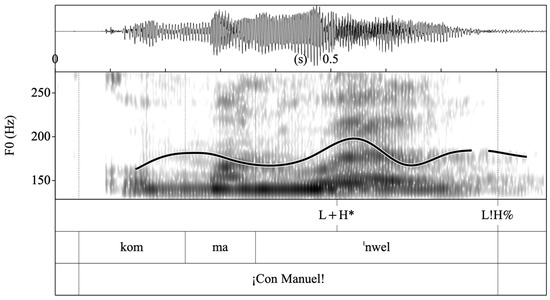
Figure 25.
Waveform, spectrogram and F0 trace of the what-exclamative ¡Con Manuel! in L2 Spanish (F15, level C1) produced with the target-like L+H* L!H% pattern.
At first sight, it seems easier to acquire a new tonal pattern ((L+)H*+L) (systemic dimension) than to re-apply a known pattern (L!H%) to a different context (semantic dimension). However, L2 learners also exhibited difficulty in L2 Spanish with HL%, which does not exist in L1 Czech either. This boundary tone was only produced by three learners of Spanish. Although I believe it is the semantic dimension that presents the greatest amount of difficulty for L2 learners, we should not rule out other explanations. For example, frequency can play an important role here too: the (L+)H*+L pitch accent is found in very different types of sentences in Italian and is more frequent than L!H% or HL% in Spanish. Moreover, as suggested in Pešková (2020), the Italian pattern is more prominent perceptually. Anecdotally, when people try to imitate Italian, they tend to use this pattern. This would also explain why L2 learners overuse the (L+)H*+L pattern in the prenuclear position or in inappropriate contexts such as neutral vocatives, in which L1 speakers would produce L+H* (Pešková 2019).
Elsewhere the data show a range of variation and a sharper divergence from the L1 data in the prenuclear position. This suggests that prenuclear pitch accents tend to be much more susceptible to cross-linguistic influence because they have less semantic weight than the nuclear position, which conveys meaning, and because they also exhibit larger variation in L1 varieties, probably for the same reason.
The fourth and last question (Q4) was directed at the effect of individual factors (AOL, LOR, AUL) on the accuracy in L2 intonation. As we have noted, the statistical analysis revealed that LOR, AOL and AUL did not intervene very clearly. It could be hypothesized that the fact that learners were exposed mostly to one or more different L2 regional varieties would better explain the observed variation and the creation of mixed patterns. Additional factors potentially having an impact on L2 speech such as a general talent for pronunciation or individual aptitudes related to motor and music skills, mimicry or memory should not be ignored and deserve attention in future studies. And finally, follow-up research should also examine whether the relationship between production accuracy and foreign accent perceived by L1 listeners is symmetric or asymmetric.
7. Concluding Remarks
How much does transfer matter in the acquisition of L2 intonation? It is not very easy to quantify L1-to-L2 transfer in intonation, since L2 verbal output is not simply made up of target-like features or L1-transferred features, but also a range of mixed patterns, which are difficult to interpret. Despite such difficulties, both positive and negative influences can be detected across all learners and contexts, but to different degrees. The results of the present study, in which 20 Czech learners of Italian were compared with 20 Czech learners of Spanish, suggest that intonation is in fact “learnable”, albeit the two groups of learners diverged from L1 speakers in several ways. Whereas the learners were quite successful in learning new patterns in the nuclear position, they exhibited more difficulties with boundary tones, independently of whether the tone was present or absent in the learner’s L1. It may well be that factors such as perceptual prominence and frequency can explain this finding and predict the difficulties in L2 intonation learning. With regard to individual factors bearing on a learner’s ability to approximate L2 intonation targets, the findings exhibited no significant effects derived from the length of residence abroad (LOR), the age of learning (AOL) or the amount of L2 use (AUL).
These results constitute a step forward in our growing understanding of the study of the acquisition of L2 intonation. That said, considerable work deserves to be done in this area, particularly given its rich potential for practical application in the language learning classroom.
Funding
This research received no external funding.
Institutional Review Board Statement
Not applicable.
Informed Consent Statement
Informed consent was obtained from all subjects involved in the study.
Data Availability Statement
Data are not available to the public.
Conflicts of Interest
The author declares no conflict of interest.
Appendix A

Table A1.
Overview of the learners who participated in the study (F = female, M = male).
Table A1.
Overview of the learners who participated in the study (F = female, M = male).
| L2 | Learner | Age | Level | LOR | AOL | AUL (hours/week) |
|---|---|---|---|---|---|---|
| Italian | F31 | 24 | C1 | 1 month in the Dolomites, 5 months in Siena | 18 | 2 |
| F32 | 38 | B1 | Short visits to different locations in Italy | 20 | 1 | |
| F33 | 26 | C1 | 5 months in Padua | 19 | 4 | |
| F34 | 23 | B2 | Short visits to different locations in Italy | 14 | 2 | |
| F35 | 23 | C1 | 16 months (Roma, Ravenna, Cervia) | 18 | 28 | |
| F36 | 29 | B2 | 3 months in Parma, several weeks in Turin and Milan | 20 | 0 | |
| F37 | 30 | C2 | 3 months in Perugia, regular work trips to different locations | 23 | 40 | |
| F38 | 37 | C2 | 5 years in Tuscany and Rome | 18 | 0 | |
| F39 | 36 | C2 | 6 years in San Benedetto del Tronto | 19 | 2 | |
| F40 | 23 | B2 | Different short visits to Italy | 18 | 4 | |
| F41 | 26 | C1 | 6 months in Rome; many short visits to Ravenna | 19 | 5 | |
| F42 | 22 | B1 | 2 months in Genoa | 19 | 10 | |
| F43 | 24 | B2 | Short visits to different locations in Italy | 18 | 6 | |
| M44 | 43 | B1 | 2 weeks in Calabria | 33 | 2 | |
| F45 | 22 | C1 | 4 months in Perugia | 20 | 4 | |
| M46 | 28 | C1 | Short visits to different locations in Italy | 20 | 5–6 | |
| F47 | 24 | B1 | 5 months in Verona | 20 | 0 | |
| F48 | 26 | B2 | 14 months in Florence | 11 | 2 | |
| F49 | 27 | C1 | Short visits to different locations in Italy | 12 | 30 | |
| F50 | 31 | B1 | 3 months in Calabria | 25 | 1 | |
| Spanish | M01 | 30 | C2 | 1 year in different locations in Spain, 1 year in different Latin American countries | 22 | 5 |
| M02 | 40 | B1 | Short visits to different locations in Spain | 35 | 1 | |
| F04 | 29 | B2 | Short visits to different locations in Spain | 20 | 2 | |
| F05 | 29 | B1 | Short visit in Catalonia | 14 | 2 | |
| F06 | 23 | C1 | Short visits to different locations in Spain, Mexico, Guatemala | 17 | 20 | |
| F07 | 21 | B2 | No stay in an L2-speaking country | 22 | 1–2 | |
| F08 | 20 | B2 | No stay in an L2-speaking country | 15 | 20 | |
| F09 | 24 | B2 | 1 year in different locations in Spain | 21 | 10 | |
| F10 | 27 | B2 | Short visits to different locations in Spain, Mexico | 13 | 10 | |
| F11 | 19 | C1 | 1 month in the south of Spain | 17 | 8 | |
| M12 | 33 | B2 | Short visits to different locations in Spain and Central America | 24 | 2 | |
| F13 | 31 | C2 | 5 years in Spain | 16 | 3 | |
| M14 | 22 | C1 | Short visits to different locations in Spain | 17 | 2–3 | |
| F15 | 24 | C1 | 6 months in Barcelona and short visits to different locations in Spain | 10 | 3 | |
| F16 | 20 | C2 | Short visits to different locations in Spain | 10 | 40 | |
| M17 | 20 | C1 | 3 months in Valencia | 13 | 4 | |
| F18 | 23 | C1 | 10 months in Valencia; short visits to Cuba | 17 | 8 | |
| M19 | 34 | B2 | 1 month in the north of Spain | 10 | 2 | |
| F20 | 45 | B1 | Short visits to different locations in Spain | 19 | 1 | |
| M21 | 30 | C1 | 2 years in Barcelona | 14 | 1 |
Notes
| 1 | Some of these non-neutral sentences (contexts 1–3) are also presented in Pešková (2020); however, the present paper includes additional contexts, fully discusses the results within the LILt and tests individual factors in order to explain the accuracy in L2 intonational patterns. |
| 2 | The potential influence of other previously acquired L2s is not covered in the present study. |
| 3 | The reliability of this manual labelling is discussed in Pešková (2020), in which the same annotation was carried out manually and then compared against automatic transcription of intonation using the Eti_ToBI tool (Elvira-García et al. 2016). Overall agreement was relatively high at 79% for all tonal events. |
| 4 | The H+L*+H of the present study corresponds to the pitch accent L*+>H in Gili Fivela et al. (2015). |
| 5 | To make a statistical analysis possible here, the low values for L+<H*, H*+L and L+H*+L were excluded and Fisher’s exact test was used. |
| 6 | To make a statistical analysis possible, the low values for L+<H*, H*+L and L+H*+L were not included for the Spanish groups. As for the two Italian varieties, the analysis included L*, H*, L*+H, L+H* and (L+)H*+L. |
| 7 | I use the term “residence” here to refer in general to the time spent in an L2-speaking country, independently of whether the learners had just made short visits or had spent a longer period of time there. |
References
- Aguilar, Lourdes, Carme De-La-Mota, and Pilar Prieto. 2009. Sp_ToBI Training Materials. Available online: http://prosodia.upf.edu/sp_tobi/ (accessed on 22 June 2021).
- Best, Catherine T., and Michael D. Tyler. 2007. Nonnative and Second-Language Speech Perception: Commonalities and Complementarities. In Language Experience in Second Language Speech Learning. Edited by Ocke-Schwen Bohn and Murray J. Munro. Amsterdam and Philadelphia: John Benjamins, pp. 13–34. [Google Scholar] [CrossRef]
- Blum-Kulka, Shoshana, Juliane House, and Gabriele Kasper. 1989. Investigating Cross-Cultural Pragmatics: An Introductory Overview. In Cross-Cultural Pragmatics: Requests and Apologies. Edited by Shoshana Blum-Kulka, Juliane House and Gabriele Kasper. Norwood: Ablex, pp. 1–34. [Google Scholar]
- Boersma, Paul, and David Weenink. 1992–2022. Praat: Doing Phonetics by Computer. Available online: http://www.praat.org (accessed on 13 September 2020).
- Brysbaert, Marc. 2021. Power considerations in bilingualism research: Time to step up our game. Bilingualism: Language and Cognition 24: 813–18. [Google Scholar] [CrossRef]
- CEFR. 2018. Common European Framework of Reference for Languages: Learning, Teaching, Assessment. In Companion Volume with New Descriptors. Language Policy Program. Strasbourg: Council of Europe. Available online: http://www.coe.int/lang-cefr (accessed on 25 December 2018).
- Chun, Dorothy. 1998. Signal Analysis Software for Teaching Discourse Intonation. Language Learning & Technology 2: 74–93. [Google Scholar]
- Colantoni, Laura, and Jorge Gurlekian. 2004. Convergence and Intonation: Historical Evidence from Buenos Aires Spanish. Bilingualism: Language and Cognition 7: 107–19. [Google Scholar] [CrossRef]
- Colantoni, Laura, Gabrielle Klassen, Matthew Patience, Malina Radu, and Olga Tararova. 2016. Task-Effects in the L2 Perception and Production of English Sentence Types by L1 Spanish Speakers. Paper presented at 8th International Conference on Speech Prosody 2016, Boston, MA, USA, June 3; pp. 11–15. [Google Scholar]
- Colantoni, Laura, Jeffrey Steele, and Paola Escudero. 2015. Second Language Speech. Theory and Practice. Cambridge: Cambridge University Press. [Google Scholar] [CrossRef]
- De Leeuw, Esther, Ineke Mennen, and James M. Scobbie. 2012. Singing a different tune in your native language: First language attrition of prosody. International Journal of Bilingualism 16: 101–16. [Google Scholar] [CrossRef]
- Derwing, Tracey M., and Murray J. Munro. 2015. Pronunciation Fundamentals. Evidence-Based Perspectives for L2 Teaching and Research. Amsterdam and Philadelphia: John Benjamins. [Google Scholar] [CrossRef]
- Dewaele, Jean-Marc, and Adrian Furnham. 2000. Personality and speech production: A pilot study of second language learners. Personality and Individual Differences 28: 355–65. [Google Scholar] [CrossRef]
- Duběda, Tomáš. 2014. Czech Intonation: A Tonal Approach. Slovo a Slovesnost 75: 83–98. [Google Scholar]
- Ellis, Rod. 1994. The Study of Second Language Acquisition. Oxford: Oxford University Press. [Google Scholar] [CrossRef]
- Elvira-García, Wendy, Paolo Roseano, Fernández Planas, Ana Maria, and Eugenio Martínez Celdrán. 2016. A Tool for Automatic Transcription of Intonation: Eti-ToBI a ToBI Transcriber for Spanish and Catalan. Language Resources and Evaluation 50: 767–92. [Google Scholar] [CrossRef]
- Estebas-Vilaplana, Eva, and Pilar Prieto. 2010. Castilian Spanish Intonation. In Transcription of Intonation of the Spanish Language. Edited by Pilar Prieto and Paolo Roseano. Munich: Lincom Europa, pp. 17–48. [Google Scholar]
- Féry, Caroline. 2010. Indian Languages as Intonational ‘Phrase Languages’. In Problematizing Language Studies. Cultural, Theoretical and Applied Perspectives. Essays in Honor of Rama Kant Agnihotri. Edited by S. Imtiaz Hasnain and Shreesh Chaudhary. New Delhi: Aakar Books, pp. 288–312. [Google Scholar] [CrossRef]
- Flege, James E. 1987. The Production of “New” and “Similar” Phones in a Foreign Language: Evidence for the Effect of Equivalence Classification. Journal of Phonetics 15: 47–65. [Google Scholar] [CrossRef]
- Flege, James E. 1995. Second Language Speech Learning: Theory, Findings, and Problems. In Speech Perception and Linguistic Experience: Theoretical and Methodological Issues in Cross-Language Research. Edited by W. Strange. Timonium: York Press, pp. 233–77. [Google Scholar]
- Flege, James E., Ocke-Schwen Bohn, and Sunyoung Jang. 1997. Effects of Experience on Non-Native Speakers’ Production and Perception of English Vowels. Journal of Phonetics 25: 437–70. [Google Scholar] [CrossRef]
- Frota, Sónia, and Pilar Prieto, eds. 2015. Intonation in Romance. Oxford: Oxford University Press. [Google Scholar] [CrossRef]
- Gabriel, Christoph, and Elena Kireva. 2014. Prosodic Transfer in Learner and Contact Varieties: Speech Rhythm and Intonation of Buenos Aires Spanish and L2 Castilian Spanish Produced by Italian Native Speakers. Studies in Second Language Acquisition 36: 257–81. [Google Scholar] [CrossRef]
- Gabriel, Christoph, Ingo Feldhausen, and Andrea Pešková. 2011. Prosodic Phrasing in Porteño Spanish. In Intonational Phrasing in Romance and Germanic: Cross-Linguistic and Bilingual Studies. Edited by Christoph Gabriel and Conxita Lleó. Amsterdam and Philadelphia: John Benjamins, pp. 153–82. [Google Scholar] [CrossRef]
- Gabriel, Christoph, Ingo Feldhausen, Andrea Pešková, Laura Colantoni, Su-Ar Lee, Valeria Arana, and Leopoldo Labastía. 2010. Argentinian Spanish Intonation. In Transcription of Intonation of the Spanish Language. Edited by Pilar Prieto and Paolo Roseano. Munich: Lincom, pp. 285–317. [Google Scholar]
- Gass, Susan M. 1988. Second Language Acquisition and Linguistic Theory: The Role of Language Transfer. In Linguistic Theory in Second Language Acquisition. (=Studies in Theoretical Psycholinguistics 8). Edited by Suzanne Flynn and Wayne O’Neil. Dordrecht: Springer, pp. 384–403. [Google Scholar] [CrossRef]
- Gass, Susan M., and Larry Selinker. 2008. Second Language Acquisition: An Introductory Course, 3rd ed. New York: Routledge. [Google Scholar] [CrossRef]
- Gili Fivela, Barbara, Cinzia Avesani, Marco Barone, Giuliano Bocci, Claudia Crocco, Mariapaola D’Imperio, Rosa Giordano, Giovanna Marotta, Michelina Savino, and Patrizia Sorianello. 2015. Intonational Phonology of the Regional Varieties of Italian. In Intonation in Romance. Edited by Sónia Frota and Pilar Prieto. Oxford: Oxford University Press, pp. 140–97. [Google Scholar] [CrossRef]
- Henriksen, Nicholas C. 2012. The Intonation and Signaling of Declarative Questions in Manchego Peninsular Spanish. Language and Speech 55: 543–76. [Google Scholar] [CrossRef]
- Hualde, José I., and Pilar Prieto. 2015. Intonational Variation in Spanish: European and American Varieties. In Intonation in Romance. Edited by Sónia Frota and Pilar Prieto. Oxford: Oxford University Press, pp. 350–91. [Google Scholar] [CrossRef]
- Hualde, José I., and Pilar Prieto. 2016. Towards an International Prosodic Alphabet (IPrA). Laboratory Phonology: Journal of the Association for Laboratory Phonology 7: 5. [Google Scholar] [CrossRef]
- IBM. 2022. SPSS Statistics for macOS. (Version 28.0.). Armonk: IBM. [Google Scholar]
- Jun, Sun-Ah, ed. 2005. Prosodic Typology: The Phonology of Intonation and Phrasing. Oxford: Oxford University Press. [Google Scholar] [CrossRef]
- Jun, Sun-Ah, ed. 2014. Prosodic Typology II: The Phonology of Intonation and Phrasing. Oxford: Oxford University Press. [Google Scholar] [CrossRef]
- Ladd, Robert. 1996. Intonational Phonology. Cambridge: Cambridge University Press. [Google Scholar] [CrossRef]
- Ladd, Robert. 2008. Intonational Phonology, 2nd ed. Cambridge: Cambridge University Press. [Google Scholar] [CrossRef]
- Matras, Yaron. 2009. Language Contact. Cambridge: Cambridge University Press. [Google Scholar] [CrossRef]
- Méndez Seijas, Jorge. 2018. L2 Spanish Intonation in a Short-Term Study Abroad Program. In The Routledge Handbook of Study Abroad Research and Practice. Edited by Cristina Sanz and Alfonso Morales-Front. New York and London: Routledge, pp. 89–104. [Google Scholar] [CrossRef]
- Mennen, Ineke, Aoju Chen, and Fredrik Karlsson. 2010. Characterising the internal structure of learner intonation and its development over time. Paper presented at New Sounds 2010 (6th International Symposium on the Acquisition of Second Language Speech), Barcelona, Spain, April 20–22; Poznan: Adam Mickiewicz University, pp. 319–24. [Google Scholar]
- Mennen, Ineke, Felix Schaeffler, and Catherine Dickie. 2014. Second language acquisition of pitch in German learners of English. Studies in Second Language Acquisition 36: 303–29. [Google Scholar] [CrossRef]
- Mennen, Ineke. 2004. Bi-Directional Interference in the Intonation of Dutch Speakers of Greek. Journal of Phonetics 32: 543–63. [Google Scholar] [CrossRef]
- Mennen, Ineke. 2015. Beyond Segments: Towards a L2 Intonation Learning Theory. In Prosody and Language in Contact: L2 Acquisition, Attrition and Languages in Multilingual Situations. Edited by Elisabeth Delais-Roussarie, Mathieu Avanzi and Sophie Herment. Berlin and Heidelberg: Springer, pp. 171–88. [Google Scholar] [CrossRef]
- Nicora, Francesca, Laura Incalcaterra Mcloughlin, and Barbara Gili Fivela. 2018. Impact of Prosodic Training on Italian as L2 by Hiberno-English Speakers: The Case of Polar Questions. Paper presented at 9th International Conference on Speech Prosody 2018, Poznań, Poland, June 13–16; Poznan: Adam Mickiewicz University, pp. 970–74. [Google Scholar]
- O’Rourke, Erin. 2004. Peak Placement in Two Regional Varieties of Peruvian Spanish Intonation. In Contemporary Approaches to Romance Linguistics. Edited by Julie Auger, J. Clancy Clements and Barbara Vance. Amsterdam and Philadelphia: John Benjamins, pp. 321–41. [Google Scholar] [CrossRef]
- Oyama, Susan. 1976. A sensitive period for the acquisition of a nonnative phonological system. Journal of Psycholinguistic Research 5: 261–83. [Google Scholar] [CrossRef]
- Palková, Zdena. 1994. Fonetika a fonologie češtiny. S obecným úvodem do problematiky oboru. Prague: Karolinum. [Google Scholar]
- Pešková, Andrea. 2017. Czech ToBI. Paper presented at Phonetics and Phonology in Europe 2017, Cologne, Germany, June 12–14. [Google Scholar]
- Pešková, Andrea. 2019. L2 Italian and L2 Spanish Vocatives Produced by L1 Czech Learners: Transfer and Prosodic Overgeneralization. Paper presented at 19th International Congress of Phonetic Sciences 2019, Melbourne, Australia, August 5–9; pp. 1932–36. [Google Scholar]
- Pešková, Andrea. 2020. L2 Spanish and Italian Intonation: Accounting for the Different Patterns Displayed by L1 Czech and German Learners. Postdoctoral thesis, Osnabrück University, Osnabrück, Germany. Under review in Open Romance Linguistics, Language Science Press. [Google Scholar]
- Pešková, Andrea. 2021. Gibt es melodische Konstruktionen? Erwerb von W-Fragen im L2-Italienischen und L2-Spanischen. In Konstruktionsgrammatische Zugänge zu Romanischen Sprachen. Edited by Hans-Jörg Döhla and Anja Hennemann. Berlin: Frank & Timme (Strukturelle Dynamik und Sprachkontakt in der Romania), pp. 241–71. [Google Scholar]
- Pešková, Andrea. forthcoming. The Intonational Phonology of Czech. In Prosodic Typology III: The Phonology of Intonation and Phrasing. Edited by Sun-Ah Jun and Sameer ud Dowla Khan. Oxford: Oxford Scholarship.
- Pierrehumbert, Janet B. 1980. The Phonology and Phonetics of English Intonation. Ph.D. dissertation, Massachusetts Institute of Technology, Cambridge, MA, USA. [Google Scholar]
- Piske, Thorsten, Ian R. A. MacKay, and James E. Flege. 2001. Factors Affecting Degree of Foreign Accent in an L2: A Review. Journal of Phonetics 29: 191–215. [Google Scholar] [CrossRef]
- Prieto, Pilar, and Paolo Roseano, eds. 2010. Transcription of Intonation of the Spanish Language. Munich: Lincom Europa. [Google Scholar]
- Prieto, Pilar. 2001. L’entonació dialectal del català: El cas de les frases interrogatives absolutes. In Actes del Novè Col·loqui d’Estudis Catalans a Nord-Amèrica. Edited by August Bover, Maria-Rosa Lloret and Mercè Vidal-Tibbits. Barcelona: Publicacions de l’Abadia de Montserrat, pp. 347–77. [Google Scholar]
- Pustka, Elissa, Christoph Gabriel, Trudel Meisenburg, Monja Burkard, and Kristina Dziallas. 2018. (Inter-) Fonología del Español Contemporáneo (I)FEC: Metodología de un programa de investigación para la fonología de corpus. Loquens 5: 1–16. [Google Scholar] [CrossRef]
- Romera, Magdalena, and Gorka Elordieta. 2020. Information-Seeking Question Intonation in Basque Spanish and its Correlation with Degree of Contact and Language Attitudes. Languages 5: 1–21. [Google Scholar] [CrossRef]
- Santiago, Fabian, and Elisabeth Delais-Roussarie. 2015. The Acquisition of Question Intonation by Mexican Spanish Learners of French. In Prosody and Language in Contact: L2 Acquisition, Attribution and Language in Multilingual Situations. Edited by Elisabeth Delais-Roussarie, Mathieu Avanzi and Sophie Herment. Berlin/Heidelberg: Springer, pp. 243–70. [Google Scholar]
- Selkirk, Elisabeth O. 1984. Phonology and Syntax. The Relation between Sound and Structure. Cambridge: MIT Press. [Google Scholar]
- Sichel-Bazin, Rafèu, Trudel Meisenburg, and Pilar Prieto. 2015. Intonational Phonology of Occitan: Towards a Prosodic Transcription System. In Intonation in Romance. Edited by Sónia Frota and Pilar Prieto. Oxford: Oxford University Press, pp. 198–234. [Google Scholar]
- Sorace, Antonella. 2011. Pinning down the concept of “interface” in bilinguals. Linguistic Approaches to Bilingualism 1: 1–33. [Google Scholar] [CrossRef]
- Trofimovich, Pavel, and Wendy Baker. 2006. Learning second language suprasegmentals: Effect of L2 experience on prosody and fluency characteristics of L2 speech. Studies in Second Language Acquisition 28: 1–30. [Google Scholar] [CrossRef]
- Ueyama, Motoko. 1997. The Phonology and Phonetics of Second Language Intonation: The Case of “Japanese English”. Paper presented at Fifth European Conference on Speech Communication and Technology, Rhodes, Greece, September 22–25; pp. 2411–14. [Google Scholar]
- van Maastricht, Lieke, Emiel Krahmer, and Marc Swerts. 2016. Prominence patterns in a second language: Intonational transfer from Dutch to Spanish and vice versa. Language Learning 66: 124–58. [Google Scholar] [CrossRef]
Publisher’s Note: MDPI stays neutral with regard to jurisdictional claims in published maps and institutional affiliations. |
© 2022 by the author. Licensee MDPI, Basel, Switzerland. This article is an open access article distributed under the terms and conditions of the Creative Commons Attribution (CC BY) license (https://creativecommons.org/licenses/by/4.0/).